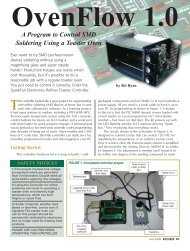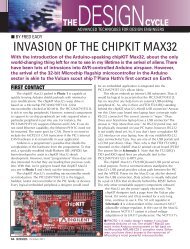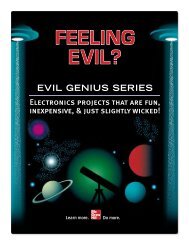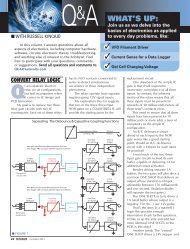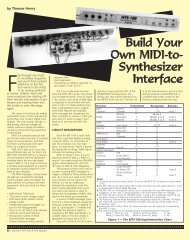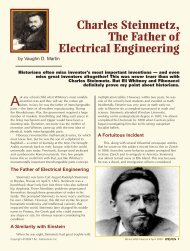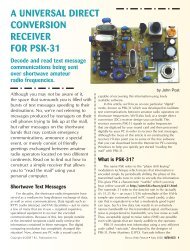You also want an ePaper? Increase the reach of your titles
YUMPU automatically turns print PDFs into web optimized ePapers that Google loves.
PARTS LISTITEM PART NUMBER QTY❑ Housing 103158** (Jameco) 2❑ Socket pins 100766** (Jameco) 55❑ Header 160882 * (Jameco) 2❑ PB switch 104-0013-EVX 4❑ SPST switch 108-1MS1T1B1M1QE-EVX 1❑ SPDT switch 108-1MS1T1B1M1QE-EVX 1❑ Power connector 163-2325-E 1❑ Power connector 1710-2532 1❑ 3.5 mm Phone jack 161-7300-EX 1❑ XLR3-F 164-7133 1❑ 1/4” Phone jack 16PJ022 1❑ Phono jack 16PJ052 1❑ 1/4” Phone jack 16PJ080 1❑ 10Ω 2W 282-10-RC 1❑ 1K 292-1.0K-RC 10❑ 1M 292-1.0M-RC 1❑ 1.7K 292-1.7K-RC 1❑ 100K 292-100K-RC 1❑ 100 292-100-RC 2❑ 10K 292-10K-RC 12❑ 19.6K 292-19.6K-RC 1❑ 2.1K 292-2.10K-RC 1❑ 20.5K 292-20.5K-RC 1❑ 3.3K 292-3.3K-RC 1❑ 3.57K 292-3.57K-RC 2❑ 332K 292-332K-RC 1❑ 47K 292-47K-RC 1❑ 5.49K 292-5.49K-RC 1❑ 8.06K 292-8.06K-RC 1❑ 9K 292-9.09K-RC 1❑ 100Ω 30BJ250-100 1❑ 2.7K 30BJ500-2.7K 1❑ 42TL019 42TL019 1❑ TS912 511-TS912BID 3❑ FAN1616 512-FAN1616AD33X 1❑ GF1A 512-GF1A 2❑ 7805 512-KA7805ATU 1❑ Socket 538-52437-3072 1❑ Socket 571-5-104652-5 1❑ 220 pf 581-08051A221K 1❑ .0022 µF 581-08053A222K 1❑ 470 pf 581-08055A471K 1❑ 680 pf 581-08055A681K 1❑ .47 µF 581-0805ZC474K 8❑ Enclosure 377-1163-ND (Digi-Key) 1❑ 2N3904 625-2N3904 2❑ 100 µF 647-UVR1E101MED 1❑ 20K 72-T93YA-20K 3❑ F-51553 805-F51553GNBJAEN 1❑ Relay 806-9081C1-05-00 1❑ 1.0 µF 80-C1206C105K3R 5❑ 4.7 µF 80-C1206C475Z4V 4❑ ADS7816 ADS7816U-ND (Digi-Key) 1❑ Microprocessor RCM4120 1❑ SN74LVC1G66DBVR 296-13253-1-ND (Digi-Key) 3❑ LED 606-CMD3750 1* 160882 Headers are cut to size and require 100766 pinsand housing** 100766 socket pins requires 103158 housing cut to sizeThe system needs about 55 total pins — this is equivalent totwo pieces each of 103158 and 160882NOTE: All items are from Mouser unless stated otherwise.A more detailed parts list is available at www.nutsvolts.com.50 August 2008away from the analog amplification stages as muchas possible; and (2) to enable the flexibility in theaudio processing so the builder can develop his/herown circuit and control it from the system.The processor circuit (Figure 5) shows theconnections from the microprocessor board to theother circuits. The board also has the A-to-Dconverter and the pull-up resistors for the switches.The ADC is powered by the 5V regulator. Assuch, its SPI output signal is a 5V logic level. Themicroprocessor board I am using can handle only3.3V input signals — that is why there is a voltagedivider on the output of the ADC.I have selected a 2 MHz clock speed for theSPI system. This is used for both the analogconverter and the display. The interrupt serviceroutine that is used to sample the input signal takesapproximately 12 to 16 µs, depending on theprocessor you are using. This means that thehighest theoretical sampling frequency is either80 kHz or 60 kHz. The fastest sample rate the ADCwill support is 200 kHz. This is equivalent to an SPIclock rate of 3.2 MHz since it takes 16 SPI clocksto read the converter. The display can handle abouta 7 MHz clock. So, I could increase the clockspeed to 3 MHz and get a 50% increase in thesample rate. However, this is not necessary sincethe system is designed for the audio spectrum.All of the values can be modified via the menusystem can be stored in the Flash memory of themicroprocessor board. This includes the ADCcalibration, the frequency “window” you wantto view, sample size, etc. The current menusystem allows you to store up to 10 sets of thesevalues. There is a complete and detaileddescription of the menu system on my website atwww.qsl.net/k3pto.Some Construction NotesA few comments about the BOM. Althoughthe BOM shows mostly Mouser part numbers,many of them are available from other sources,including Digi-Key and Jameco. If you want to savesome money, I suggest you search the sites for thebest prices on the higher cost items. Bear in mindthat these companies may have a minimum dollarvalue for orders. Many of the parts for this projectdo not have critical values. For instance, the gainresistors in the analog circuit may be customizedfor your application. The transistor type used forK1 on the analog board and the backlight on thedigital board can be any small signal NPN oreven an FET (2N7000). The PCBs (three) can bepurchased from FAR Circuits as a set.I recommend that you purchase two of theLCD boards, as well as two of the LCD connectors.




